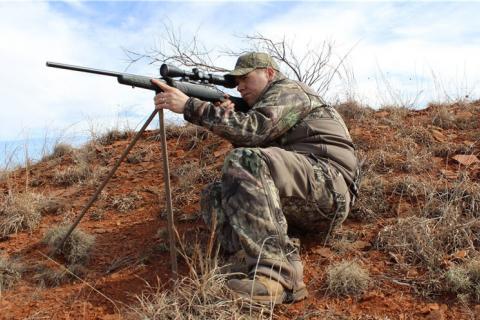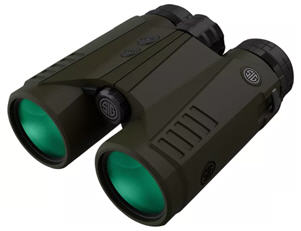
The popularity of calling in wildlife predators in the last few years, specifically coyotes is fast becoming one of the top hunting categories. Calling coyotes is an exciting, adrenaline rush experience that many hunters are eager to try. They can call in coyotes, not only for the the excitement, but also to reap the benefits of helping to reduce coyote populations which in turn helps manage the hunting land for the deer, turkey and bird populations.
One thing to note, it doesn’t take long for the beginning predator hunter to realize that it's not as easy as going out and sounding like a dying rabbit, followed by successfully shooting a coyote. Coyotes are a smart animals and hunters have to put some work into calling coyotes in order to be successful in harvesting one.
 An often asked question that I hear after a hunter has been trying to call predators unsuccessfully is ... where to set up. In my experience, there are many factors that goes into setting up to call coyotes. All are elements that can make or break a hunt if the hunter doesn’t put thought and effort into this process first.
An often asked question that I hear after a hunter has been trying to call predators unsuccessfully is ... where to set up. In my experience, there are many factors that goes into setting up to call coyotes. All are elements that can make or break a hunt if the hunter doesn’t put thought and effort into this process first.
Create the right hunting set up when calling in coyotes with these tips.
Coyotes Have a Strong Sense of Smell, be Aware of the Wind Direction

Super Fine Odorless Powder
A coyote has one of the best senses of smell of any animal that is commonly hunted. Most predator hunters make the wind direction their biggest priority when it comes to where they sit when trying to call coyotes.
Tip: Shop Scent Elimination right here
When hunting by myself, I prefer a crosswind, this means sitting where the wind is blowing from side to side of the direction that I am facing. The majority of coyotes will try to get down wind when responding to a call, which means they will most likely be visible in front of the hunter when trying to do so, allowing for more shot opportunities.
Tip: Always sit where the downwind side is visible for the shot. Again, most predators will try to approach with the wind in their face. If hunting with 2 or more people, always have one person facing downwind. This allows for no blind spots when a coyote responds.
 Tip: Check the wind direction with a product such as Hunter’s Specialties Winicator
Tip: Check the wind direction with a product such as Hunter’s Specialties Winicator
Use Shadows or Backdrops to Conceal From Coyotes
After determining the wind direction, the next thing to decide upon will be where to physically sit.

KILO BDX Rangefinder Kit
Hunters will want to sit elevated, for example, on the side of a hill. A location like the side of a hill allows the hunter to see when a coyote is approaching. What we don’t want is to lose sight of the coyote due to the landscape, allowing them to approach in a unexpected area, or leave the area in general without knowing which direction they headed.
I prefer sitting in front of a tree, rock or other type of landmarks that help break up my outline. I have also used fencepost, farming equipment and thick piles of brush if trees are not available. Another great way to break up ones outline is to sit in the shadows. I have sat in some fairly open country where the shadows played a big factor in staying concealed from a coyotes excellent eyesight.
Tip: Wearing camouflage hunting clothes from head to toe is always preferred. This along with sitting with a backdrop or shadows will keep the hunter hidden from approaching coyotes. Of course, keeping all movement to a minimum is preferred as well.
How Far Out to Put the Call and/or Decoy

Rangefinder
Another frequently asked question is how far to set from the caller and/or decoy. Most electronic predator callers will advertise a remote distance that works from up to 200 yards away. However, I very rarely ever set my electronic caller that far away. Most generally I will set my caller within 50 yards. This is because if a coyote responds to my calling, only to hang up 50 to 100 yards away from the call, I want the coyote to still be within shooting range.
The longer distance that my caller is away from me, the longer away the coyote is going to be when I am trying to make the shot. I also like to take a rifle and shotgun with me when calling predators. I prefer to only use the shotgun at 60 yards or closer to my location. By placing the electronic call at a closer range, the better my chances are of getting a shot with my shotgun.

Binoculars
Tip: Use a rangefinder such as Nikon Monarch 3000 Rangefinder or opt for quality rangefinding binocualres like the Sig Sauer KILO 3000BDX when setting up an electronic caller and/or a decoy. Place them at exactly 30 yards from where the hunter will be sitting. This will give a quick assurance that a coyote is within shotgun range when approaching. By knowing the distance prior to calling, the hunter will not have to try to range when the coyote is approaching, risking the shot opportunity.
It is a horrible feeling to have a coyote respond to a call, only to have the hunt spoiled because of something the he saw or got a whiff of that made him uneasy. Even worse is to have a coyote come to a call perfectly, then not be able to get a shot off because the hunter was simply sitting in the wrong place. If you will try these few tips when setting up to call your next coyote, the chances of being able to make a successful harvest will increase dramatically.
- 6156 views

